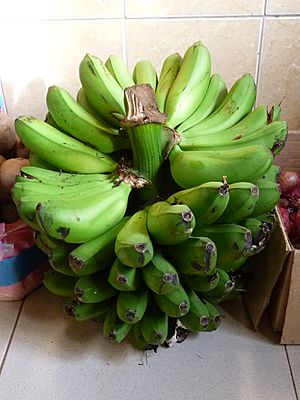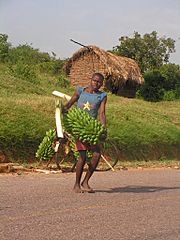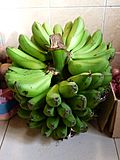Matoke facts for kids
Quick facts for kids East African Highland bananas |
|
|---|---|

A bunch of East African Highland bananas
|
|
| Species | Musa acuminata |
| Cultivar group | Musa acuminata (AAA-EA) or the Mutika/Lujugira subgroup of the AAA group |
| Origin | Uganda |
| Cultivar group members | See text |
Matoke, also known as East African Highland banana, is a special type of starchy banana. It comes from the African Great Lakes region. People usually pick Matoke when it's green. They peel it carefully, then cook it. Often, it's mashed into a meal. In countries like Uganda and Rwanda, Matoke is steamed and mashed. It's so popular that it's considered a national dish in both countries!
Matoke bananas are a very important food for many people in Uganda, Kenya, Tanzania, and other Great Lakes countries. They are also called the Mutika/Lujugira subgroup. These medium-sized green bananas are known as matoke in the local Bantu languages of Uganda and Western Kenya. For a long time, cooking bananas like Matoke have been a main food source around Lake Victoria in Kenya and Uganda, and in parts of Tanzania.
Contents
What Matoke Looks Like
Uganda Highland bananas are easy to spot! They have many black (sometimes brown or bronze) spots on their pseudostems. A pseudostem is like a fake stem made of tightly wrapped leaves. These spots make them look shiny, almost like polished metal. The outside layer of their pseudostems is a medium green, covering pink or purple layers underneath.
Their leaves are also a darker, duller green. You can really see the difference if you compare them to other banana plants from far away.
The banana flower, called an inflorescence, has hairy stalks. The special leaves around the flowers, called bracts, are purple to brown on the outside and red fading to yellow on the inside. The male flowers have cream-colored petals with yellow tips. The parts that hold pollen, called anthers, are pink, and the sticky parts that catch pollen, called stigmata, are orange.
The bananas themselves are curved and can be different lengths. They look a bit puffy with blunt tips. When they are unripe, the inside is white. When they ripen, the inside turns cream-colored.
Types of Matoke Bananas
East African Highland bananas are a special group of bananas called triploid (AAA) cultivars. Their scientific name is Musa acuminata (AAA-EA). They are related to the blood banana subspecies, which is a wild banana.
East African Highland bananas include about 200 different types, or "clones." These can be divided into five main groups:
- Mbidde (Beer Bananas): This group has 14 types. Mbidde means 'beer,' and these bananas are mostly used to make banana beer. Their inside is bitter and sticky.
- Nakitembe
- Nakabululu: These bananas are soft and tasty. They ripen quickly, but their fruits are smaller, and you get less per bunch.
- Musakala: These bananas have thin fruits with bottle-shaped tips.
- Nfuuka: These bananas have puffy, rounded, or almost rectangular fruits with medium-shaped tips. The whole bunch often looks rectangular. This group is the most varied because it tends to change (or mutate) more often. They grow heavy, packed bunches, so farmers often grow them for selling.
There are over 500 local names for the different types of Matoke bananas!
Where Matoke Comes From
East African Highland bananas arrived in Africa from Southeast Asia a long time ago, between the first and sixth centuries AD, probably through trade. They are special because they have grown and changed in the African Great Lakes region for over a thousand years. You won't find them growing naturally anywhere else in the world! Because of this, the African Great Lakes region is called the "secondary center" of banana diversity, with Southeast Asia being the first.
Matoke bananas are especially diverse in Uganda, Burundi, and Rwanda. Scientists believe that all East African Highland bananas likely came from one single banana plant that was brought to Africa less than 2000 years ago. This original plant then spread by farmers planting its shoots. Since these bananas are sterile (they don't produce seeds), farmers have been growing them for generations by planting parts of the plant. This has led to the many different types of Matoke we see today, which farmers have chosen based on what grows best in different areas.
Why Matoke Is Important
East African Highland bananas are one of the most important staple foods in the African Great Lakes region. This is especially true for Uganda, Tanzania, Kenya, Burundi, and Rwanda. In Uganda, people eat more bananas per person than anywhere else in the world! They eat about 0.70 kg (1.5 lb) of bananas every day. If you include Rwanda and Burundi, people eat about 250 to 400 kg (550 to 880 lb) per person each year, which is like eating three to 11 bananas every day!
Uganda is the second-largest producer of bananas in the world. However, it doesn't export many bananas because most of them are eaten by people within the country. Matoke bananas are so important as food that the local name matoke (or matooke) often means "food" in Uganda. Also, a type of Matoke called mbidde is used to make juice or beer.
How to Cook Matoke
To cook Matoke, people first peel the bananas using a knife. Then, they wrap the peeled bananas in banana leaves (or sometimes plastic bags). These bundles are placed in a cooking pot, often called a Swahili: sufuria, on top of banana stalks. The pot is then put on a charcoal or wood fire. The Matoke is steamed for a few hours, and water is added to the bottom of the pot many times. The banana stalks at the bottom keep the wrapped fruits above the hot water.
When raw, Matoke is white and quite hard. But after cooking, it becomes soft and yellow. People then mash the Matoke while it's still wrapped in the leaves or bags. It's often served on a fresh banana leaf. Usually, it's eaten with a sauce made from vegetables, peanuts, or some kind of meat like goat or beef.
Matoke is also used to make a popular breakfast dish in Uganda called Katogo. Katogo is usually made by cooking peeled bananas with peanuts or beef, but sometimes offal (animal organs) or goat meat are used too.
In Bukoba, Tanzania, Matoke (or ebitooke) is cooked with meat or smoked catfish, and beans or groundnuts. With this method, you don't need to make a separate sauce. In this recipe, the Matoke is not mashed. Until the early 1980s, this was a very common meal in Bukoba and was eaten all year round.





